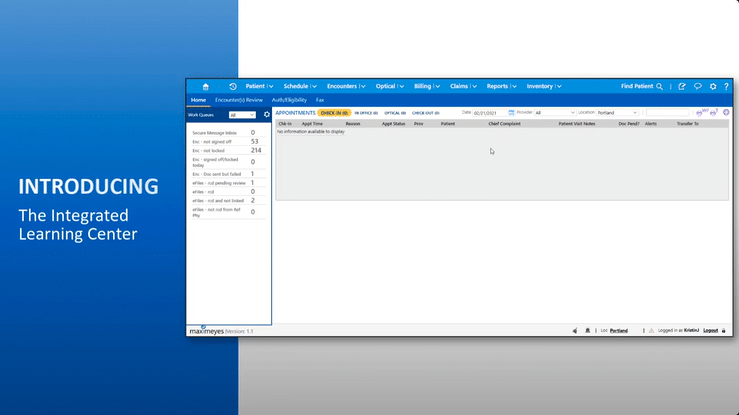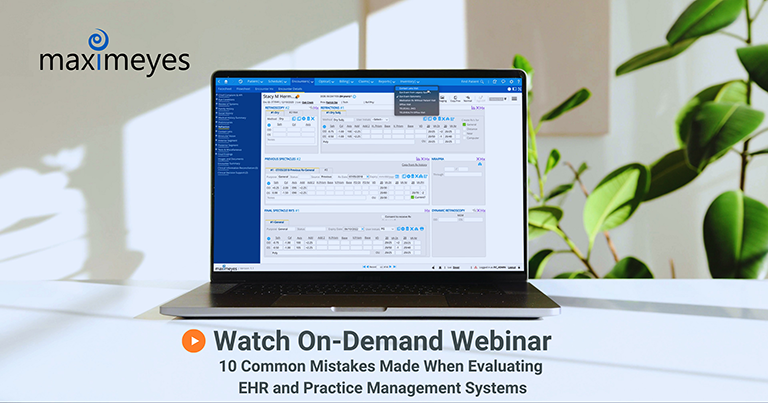
08 Feb Top 10 Optometry EHR Software Must-Haves
Are you searching for an optometry EHR that has all the tools you need to maximize efficiency so you can focus on your patients and not on the software? First Insight recently surveyed more than 400 eye care professionals using various EHRs.
Below are the top 10 “must-have” features that optometrists and staff told us they need to secure their data, achieve peak efficiency, and improve patient communications.
1. Secure Access to Data Anywhere, Anytime, and from Any Device
Cyberattacks, ransomware, and data breaches continue to be top headlines. That’s why a critical part of your patient data protection efforts should involve EHR cloud security.
Protecting patient data is the number one priority at First Insight. MaximEyes.com eye care software protects your cloud data with the Microsoft® Azure Advanced Threat Protection (ATP) cloud-based security solution, which backs up the last 30 days of your data. Data is typically recovered within 2–8 hours if a disaster should occur.
PRO TIPS: Make a checklist and verify that your EHR is doing the following to protect your data.
- Autosaves data and backs it up in real-time, so you have peace of mind and no need to press the save button constantly.
- Encrypts data backups and data in transit (data moving within your network or across the internet) and at rest (inactive data stored physically in any digital format).
- Includes built-in functionality that adheres to HIPAA regulations for user access controls, privacy, and security.
- Provides two-factor (multi-factor) and module-level authentication. Did you know that according to a 2022 Data Breach Investigations Report, 82% of data breaches happen because of stolen or weak passwords?
- Runs on any computer or laptop connected to the internet in a secure browser.
Watch Video: In less than 20 minutes, learn how to avoid the most common pitfalls of evaluating and selecting EHR and practice management eye care software in your office.
Related: MaximEyes.com Adheres to Secure Cloud Data Protection, Backup, and Disaster Recovery
2. Easy to Customize Encounter Forms and Workflows
One of the biggest challenges optometry practices face today is creating a workflow that fits your practice processes.
Customizing encounter forms to fit different workflows for different types of encounters enables the doctor to see only the needed data points. Customization declutters and reduces the number of screens and clicks required to document an exam.
For instance, MaximEyes.com optometry EHR allows you to pick and choose data fields you want to include for a type of encounter. Move the fields around like puzzle pieces on the screen to fit your workflows.
Create a one-page exam form, or create different tabs or pages for various parts of the exam if you prefer. You can even start an exam with one template and switch to a different template midway if you find an eye problem requiring a different workflow or data fields.
Data you already entered transfers to the new template automatically. You can also add to or customize the data fields provided in the default library. Even a computer novice can easily create and customize exam templates.
“Being able to customize our optometry exam templates to fit how we use the system most of the time is a critical reason why we love MaximEyes.com. It is also helpful that previous exam findings copy forward to the new patient record without re-entering data.” –Chet Myers, OD (read his success story)
3. Quick and Easy Data Entry
A robust EHR such as MaximEyes.com allows you to enter data via drop-down value lists or free text. Filter lists quickly to what’s relevant for the encounter, enter combination values, edit the value lists on the fly if you wish, and enter free text notes just about anywhere in the exam form.
You also will want to look for an eye care EHR that allows you to tab through an exam and set the order of the tabs to minimize the use of the mouse if you wish.
4. Pre-Populated Data to Start an Exam
Some EHRs, like MaximEyes.com, allow you to pre-populate data based on the type of visit, and program which data you want to pre-populate when you select the template even before you start the exam. This is very useful in having normal values set for a new patient exam or selected historical data populated when starting an exam for an established patient.
To give you an idea, shortcuts in MaximEyes.com allow you to view historical data for an entire exam or parts of an exam such as anterior segment, etc., and copy data from one field to others such as refractive data.
5. Automated Coding and Outbound Documents
At the end of the exam, one of the biggest time savers is having the diagnostic codes, procedure codes, and outbound documents for patients or other physicians already selected and waiting for approval. This eliminates the need to search for codes or documents you want to use.
When you finalize the exam, any outbound documents will automatically go to the patient portal and alert the patient or go to other physicians via secure email or e-fax.
With MaximEyes.com EHR, codes can be triggered based on your exam findings, and the outbound documents can be associated with your exam templates, so they are ready for you to approve or deselect any of them at the end of the exam.
Triggered codes mean you don’t have to remember what you documented during the visit or click on screens to look back into the exam. Automated coding helps ensure you don’t miss any pertinent diagnostic or procedure codes so that you will get paid for work performed.
“I can quickly determine how much data I want to see per screen and use customizable rules to trigger diagnostic and procedure codes, outbound documents, or alerts, making it faster and easier for me to finalize the exam.” –Peter Falk (read his success story)
6. More Data on One Screen
Some EHRs look simple and beautiful at first glance with only a few data points per screen. However, once you begin using them, you find yourself exhausted from clicking through too many tabs or screens to complete an exam and repeating the process 10 to 20 times per day.
Our survey found that most doctors prefer an EHR that allows them to neatly organize and see lots of data points per screen to get their entire exam on a single screen with scrolling or get the exam form set up on just a few screens.
Doctors also said they hated pop-up windows and frequent clicking on a button to save data before moving to another screen or parts of the system.
7. Streamlined Check-in Process via Patient Intake Forms
In MaximEyes.com, it’s easy to collect the necessary information from your patients by sending them a link to an online patient intake form via email or text. Patients can complete the form online on their smartphone, tablet, or home computer and click the submit button to send the data back to your practice.
The patient intake form collects demographics, insurance, and medical history data. For example, patients can automatically upload their insurance cards and sign consent forms to be imported into MaximEyes.com, saving staff time during check-in.
8. Two-Way E-Prescribing
Electronic prescribing (e-prescribing) and medication adherence tools built into eye care EHR systems give doctors quick access to patient medication history data, current formulary information, dosing, as well as drug-drug, drug-allergy, and duplicate therapy interaction alerts. These e-prescribing tools help drive higher levels of medication adherence and improve patient health outcomes.
Many states have passed or have introduced electronic prescribing mandates for controlled substances (EPCS). In addition, more states are taking it one step further by requiring healthcare providers to prescribe both controlled and non-controlled substances electronically.
“The bi-directional e-Prescribing integration within MaximEyes.com allows me and Dr. Downs to send prescriptions to the patient’s pharmacy and import a list of medications prescribed by other physicians back into the MaximEyes.com EHR. It’s effortless to write and submit regulatory-compliant digitally signed electronic prescriptions.” –Peter Falk, OD (read his success story).
9. Communicate with Patients via an Integrated Patient Portal
A patient portal that integrates with your eye care EHR provides the most options for engaging your patients, increasing patient satisfaction, and reducing patient care costs.
Look for a patient portal, like MaximEyes.com, that allows your patients to interact with you in one or more of the following ways:
- Receive HIPAA-compliant secure emails regarding medical treatment plans, ophthalmic test results, contact lens and spectacle prescriptions, and healthcare educational materials.
- Schedule and confirm appointments online.
- Send patient reminders on recalls, appointments, product pick up, and more.
- Pay bills conveniently online.
10. E-Training Tools for a Faster Learning Curve

MaximEyes.com includes a self-guided integrated Learning Center with online courses you can complete at your own pace 24/7. Download how-to documents and view video overviews.
Your staff can even follow step-by-step walkthroughs of common functions without ever leaving MaximEyes.com. These tools allow new users to quickly get up to speed and become proficient with the software.
“The self-guided Learning Center within MaximEyes.com gives our staff the freedom to download how-to documents and guides, view product videos, and complete courses without leaving MaximEyes.com. It is a big plus to have online resources available 24×7 that walk you through the software.” –Chet Myers, OD (read his success story)





